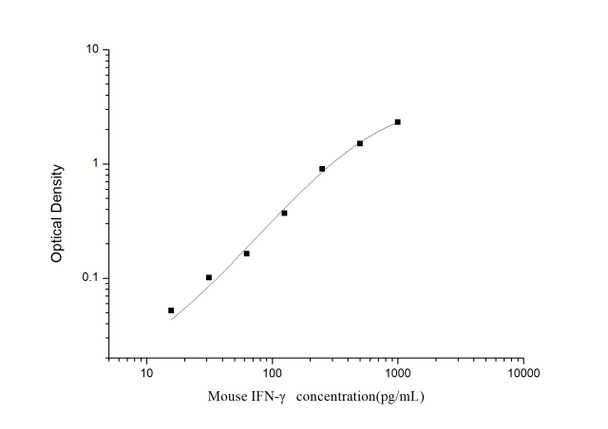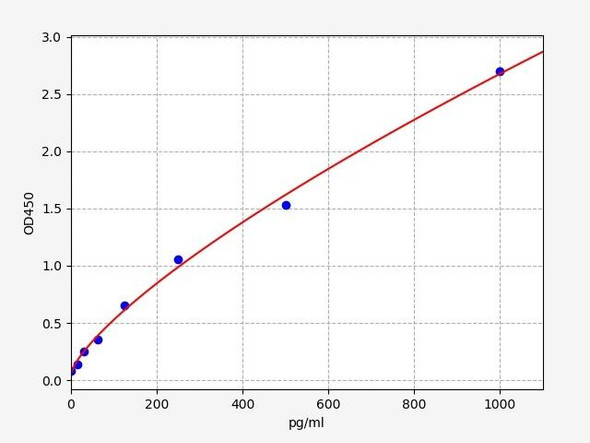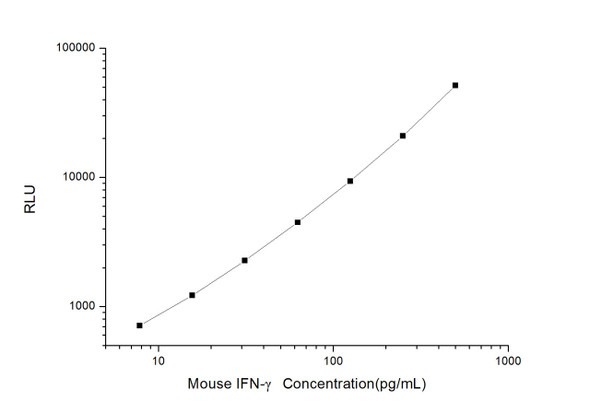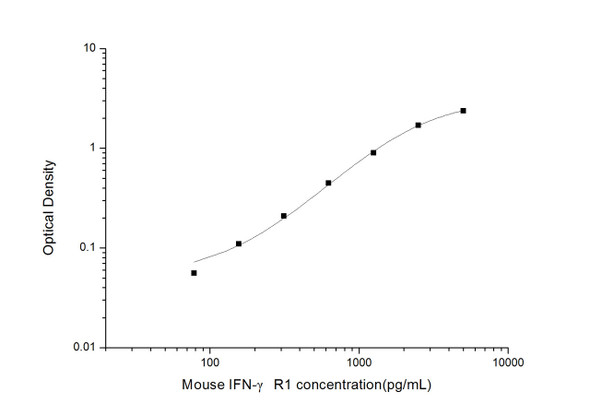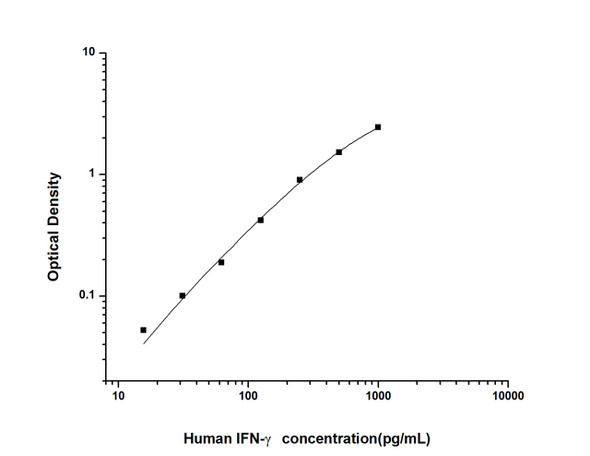Mouse Immunology ELISA Kits
Mouse IFN-gamma (Interferon Gamma) ELISA Kit (MOES00667)
- SKU:
- MOES00667
- Product Type:
- ELISA Kit
- Size:
- 96 Assays
- Uniprot:
- P01580
- Sensitivity:
- 9.38pg/mL
- Range:
- 15.63-1000pg/mL
- ELISA Type:
- Sandwich
- Synonyms:
- IFNG, IFG, IFI, Type II Interferon
- Reactivity:
- Mouse
- Sample Type:
- Serum, plasma and other biological fluids
- Research Area:
- Immunology
Description
| Assay type: | Sandwich |
| Format: | 96T |
| Assay time: | 4.5h |
| Reactivity: | Mouse |
| Detection Method: | Colormetric |
| Detection Range: | 15.63-1000 pg/mL |
| Sensitivity: | 9.38 pg/mL |
| Sample Volume Required Per Well: | 100µL |
| Sample Type: | Serum, plasma and other biological fluids |
| Specificity: | This kit recognizes Mouse IFN-gamma in samples. No significant cross-reactivity or interference between Mouse IFN-gamma and analogues was observed. |
This ELISA kit uses Sandwich-ELISA as the method. The micro ELISA plate provided in this kit has been pre-coated with an antibody specific to Mouse IFN-gamma. Standards or samples are added to the appropriate micro ELISA plate wells and combined with the specific antibody. Then a biotinylated detection antibody specific for Mouse IFN-gamma and Avidin-Horseradish Peroxidase (HRP) conjugate are added to each micro plate well successively and incubated. Free components are washed away. The substrate solution is added to each well. Only those wells that contain Mouse IFN-gamma, biotinylated detection antibody and Avidin-HRP conjugate will appear blue in color. The enzyme-substrate reaction is terminated by adding Stop Solution and the color turns yellow. The optical density (OD) is measured spectrophotometrically at a wavelength of 450 nm ± 2 nm. The OD value is proportional to the concentration of Mouse IFN-gamma. The concentration of Mouse IFN-gamma in samples can be calculated by comparing the OD of the samples to the standard curve.
| UniProt Protein Function: | IFNG: Produced by lymphocytes activated by specific antigens or mitogens. IFN-gamma, in addition to having antiviral activity, has important immunoregulatory functions. It is a potent activator of macrophages, it has antiproliferative effects on transformed cells and it can potentiate the antiviral and antitumor effects of the type I interferons. Homodimer. Released primarily from activated T lymphocytes. Belongs to the type II (or gamma) interferon family. |
| UniProt Protein Details: | Protein type:Membrane protein, integral; Cytokine; Secreted, signal peptide; Secreted Cellular Component: external side of plasma membrane; extracellular region; extracellular space; intracellular Molecular Function:cytokine activity; interferon-gamma receptor binding; protein binding Biological Process: adaptive immune response; antigen processing and presentation; apoptosis; CD8-positive, alpha-beta T cell differentiation during immune response; cell cycle arrest; defense response to bacterium; defense response to protozoan; defense response to virus; humoral immune response; immune response; inflammatory cell apoptosis; negative regulation of cell proliferation; negative regulation of epithelial cell differentiation; negative regulation of interleukin-17 production; negative regulation of myelination; negative regulation of smooth muscle cell proliferation; negative regulation of transcription from RNA polymerase II promoter; neutrophil apoptosis; neutrophil chemotaxis; positive regulation of autophagy; positive regulation of CD4-positive, CD25-positive, alpha-beta regulatory T cell differentiation during immune response; positive regulation of cell adhesion; positive regulation of cell proliferation; positive regulation of chemokine biosynthetic process; positive regulation of interleukin-1 beta secretion; positive regulation of interleukin-12 biosynthetic process; positive regulation of interleukin-12 production; positive regulation of interleukin-23 production; positive regulation of interleukin-6 biosynthetic process; positive regulation of isotype switching to IgG isotypes; positive regulation of killing of cells of another organism; positive regulation of membrane protein ectodomain proteolysis; positive regulation of MHC class II biosynthetic process; positive regulation of neuron differentiation; positive regulation of nitric oxide biosynthetic process; positive regulation of osteoclast differentiation; positive regulation of peptidyl-serine phosphorylation of STAT protein; positive regulation of synaptic transmission, cholinergic; positive regulation of T cell proliferation; positive regulation of transcription from RNA polymerase II promoter; positive regulation of transcription, DNA-dependent; positive regulation of tumor necrosis factor production; positive regulation of tyrosine phosphorylation of Stat1 protein; protein import into nucleus, translocation; regulation of growth; regulation of immune response; regulation of insulin secretion; regulation of the force of heart contraction; regulation of transcription, DNA-dependent; response to virus; sensory perception of mechanical stimulus; T cell receptor signaling pathway; unfolded protein response |
| NCBI Summary: | This gene encodes a soluble cytokine that is a member of the type II interferon class. The encoded protein is secreted by cells of both the innate and adaptive immune systems. The active protein is a homodimer that binds to the interferon gamma receptor which triggers a cellular response to viral and microbial infections. Mice deficient in this gene have increased susceptibility to viral, bacterial and parasitic infections and to several autoimmune diseases. [provided by RefSeq, Dec 2015] |
| UniProt Code: | P01580 |
| NCBI GenInfo Identifier: | 124480 |
| NCBI Gene ID: | 15978 |
| NCBI Accession: | P01580. 1 |
| UniProt Secondary Accession: | P01580,Q542B8, |
| UniProt Related Accession: | P01580 |
| Molecular Weight: | 17,907 Da |
| NCBI Full Name: | Interferon gamma |
| NCBI Synonym Full Names: | interferon gamma |
| NCBI Official Symbol: | Ifng |
| NCBI Official Synonym Symbols: | Ifg; IFN-g |
| NCBI Protein Information: | interferon gamma |
| UniProt Protein Name: | Interferon gamma |
| Protein Family: | Interferon |
| UniProt Gene Name: | Ifng |
| UniProt Entry Name: | IFNG_MOUSE |
As the OD values of the standard curve may vary according to the conditions of the actual assay performance (e. g. operator, pipetting technique, washing technique or temperature effects), the operator should establish a standard curve for each test. Typical standard curve and data is provided below for reference only.
| Concentration (pg/mL) | O.D | Average | Corrected |
| 1000 | 2.384 2.396 | 2.39 | 2.318 |
| 500 | 1.575 1.589 | 1.582 | 1.51 |
| 250 | 0.984 0.974 | 0.979 | 0.907 |
| 125 | 0.427 0.459 | 0.443 | 0.371 |
| 62.5 | 0.237 0.235 | 0.236 | 0.164 |
| 31.25 | 0.184 0.162 | 0.173 | 0.101 |
| 15.63 | 0.12 0.128 | 0.124 | 0.052 |
| 0 | 0.065 0.079 | 0.072 | -- |
Precision
Intra-assay Precision (Precision within an assay): 3 samples with low, mid range and high level Mouse IFN-gamma were tested 20 times on one plate, respectively.
Inter-assay Precision (Precision between assays): 3 samples with low, mid range and high level Mouse IFN-gamma were tested on 3 different plates, 20 replicates in each plate.
| Intra-assay Precision | Inter-assay Precision | |||||
| Sample | 1 | 2 | 3 | 1 | 2 | 3 |
| n | 20 | 20 | 20 | 20 | 20 | 20 |
| Mean (pg/mL) | 51.50 | 96.50 | 497.20 | 53.30 | 95.50 | 533.30 |
| Standard deviation | 3.20 | 4.40 | 20.90 | 3.70 | 4.70 | 17.10 |
| C V (%) | 6.21 | 4.56 | 4.20 | 6.94 | 4.92 | 3.21 |
Recovery
The recovery of Mouse IFN-gamma spiked at three different levels in samples throughout the range of the assay was evaluated in various matrices.
| Sample Type | Range (%) | Average Recovery (%) |
| Serum (n=5) | 89-103 | 96 |
| EDTA plasma (n=5) | 91-103 | 98 |
| Cell culture media (n=5) | 96-109 | 102 |
Linearity
Samples were spiked with high concentrations of Mouse IFN-gamma and diluted with Reference Standard & Sample Diluent to produce samples with values within the range of the assay.
| Serum (n=5) | EDTA plasma (n=5) | Cell culture media (n=5) | ||
| 1:2 | Range (%) | 88-98 | 86-98 | 89-102 |
| Average (%) | 93 | 91 | 95 | |
| 1:4 | Range (%) | 97-111 | 87-98 | 94-105 |
| Average (%) | 103 | 92 | 100 | |
| 1:8 | Range (%) | 97-113 | 82-98 | 99-110 |
| Average (%) | 104 | 89 | 104 | |
| 1:16 | Range (%) | 96-111 | 82-92 | 93-107 |
| Average (%) | 101 | 87 | 100 |
An unopened kit can be stored at 4°C for 1 month. If the kit is not used within 1 month, store the items separately according to the following conditions once the kit is received.
| Item | Specifications | Storage |
| Micro ELISA Plate(Dismountable) | 8 wells ×12 strips | -20°C, 6 months |
| Reference Standard | 2 vials | |
| Concentrated Biotinylated Detection Ab (100×) | 1 vial, 120 µL | |
| Concentrated HRP Conjugate (100×) | 1 vial, 120 µL | -20°C(shading light), 6 months |
| Reference Standard & Sample Diluent | 1 vial, 20 mL | 4°C, 6 months |
| Biotinylated Detection Ab Diluent | 1 vial, 14 mL | |
| HRP Conjugate Diluent | 1 vial, 14 mL | |
| Concentrated Wash Buffer (25×) | 1 vial, 30 mL | |
| Substrate Reagent | 1 vial, 10 mL | 4°C(shading light) |
| Stop Solution | 1 vial, 10 mL | 4°C |
| Plate Sealer | 5 pieces | |
| Product Description | 1 copy | |
| Certificate of Analysis | 1 copy |
- Set standard, test sample and control (zero) wells on the pre-coated plate and record theirpositions. It is recommended to measure each standard and sample in duplicate. Note: addall solutions to the bottom of the plate wells while avoiding contact with the well walls. Ensuresolutions do not foam when adding to the wells.
- Aliquot 100µl of standard solutions into the standard wells.
- Add 100µl of Sample / Standard dilution buffer into the control (zero) well.
- Add 100µl of properly diluted sample (serum, plasma, tissue homogenates and otherbiological fluids) into test sample wells.
- Cover the plate with the sealer provided in the kit and incubate for 90 min at 37°C.
- Aspirate the liquid from each well, do not wash. Immediately add 100µL of BiotinylatedDetection Ab working solution to each well. Cover the plate with a plate seal and gently mix. Incubate for 1 hour at 37°C.
- Aspirate or decant the solution from the plate and add 350µL of wash buffer to each welland incubate for 1-2 minutes at room temperature. Aspirate the solution from each well andclap the plate on absorbent filter paper to dry. Repeat this process 3 times. Note: a microplatewasher can be used in this step and other wash steps.
- Add 100µL of HRP Conjugate working solution to each well. Cover with a plate seal andincubate for 30 min at 37°C.
- Aspirate or decant the solution from each well. Repeat the wash process for five times asconducted in step 7.
- Add 90µL of Substrate Reagent to each well. Cover with a new plate seal and incubate forapproximately 15 min at 37°C. Protect the plate from light. Note: the reaction time can beshortened or extended according to the actual color change, but not by more than 30min.
- Add 50 µL of Stop Solution to each well. Note: Adding the stop solution should be done inthe same order as the substrate solution.
- Determine the optical density (OD value) of each well immediately with a microplate readerset at 450 nm.

